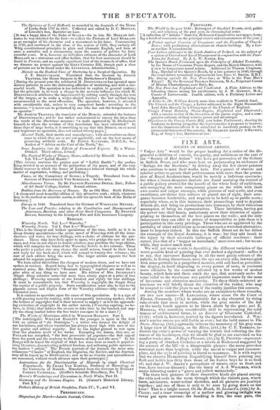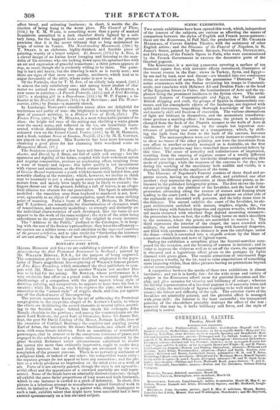FINE ARTS.
SOCIETY OF BRITISH ARTISTS.
" Vulgar Arts" would be the proper heading for a notice of the dis- graceful exhibition of conceit, incapacity, and unfairness on the part of the "Society of Bad Artists" who have got possession of the Gallery in Suffolk Street, and who seem bent on perpetuating its nickname of "Refuge for the Destitute," by driving away the few clever painters who continue to send their works here. For a parcel of obscure and inferior artists to parade their performances with more than the preten- sion of Royal Academicians, would be merely a ludicrous spectacle; but when a dozen desperate daubers are found usurping the control of a public gallery erected for the benefit of the whole body of exhibitors, and occupying the most conspicuous places on the walls with their own coarse and vulgar attempts, while pictures of real merit, and even excellence, are thrust into corners or placed out of sight, their arro- gance becomes intolerable, and requires to be held up to public scorn ; especially when, as in this instance, their proceedings tend to degrade British art, and bring its productions into contempt, by their ridiculous assumption of being its representatives. These intruders, having got the power into their hands, audaciously avow their intention of appro- priating to themselves all the best places on the walls ; and the only inducement they can offer to artists of respectability to join them is a participation in this sorry privilege. Those who are so aggrieved by the partiality of other exhibitions as to embrace such a wretched alternative, must be hopeless indeed. In this the Suffolk Street set do but follow the example of the Royal Academy, it is true ; but they add insult to the injury by their miserable burlesque of official insolence : their career, like that of a "beggar on horseback," must soon end ; but mean- while, they scatter myth mud.
We will not waste words in describing the different varieties of the worst possible kind of painting that ever decked a signboard : suffice it to say, that canvasses flaunting in all the most gaudy colours of the palette, in flaring discordance, meet the eye on every side, intermingled with some portraits in a pauperized manner, cold and hard as porcelain : the display, in itself disgusting to every person of taste, is rendered more offensive by the contrast afforded by a few works of modest beauty, which here and there catch the eye, that anxiously seeks for some relief to the wearisome and painful impression made by the mass of inveterate and obtrusive mediocrity. To these thinly-scattered at- tractions we will briefly direct the attention of the reader, who may be tempted to visit the place to see if the reality justifies this censure. Among the members whose works are an exception to these remarks, are two new names—H. LANCASTER, whose scene On the Coast at Etretat, Normandy, (172,) is admirable for a sky obscured by rising rain-clouds that seem in motion, while the gray smoke of the hat on the sandy beach appears to be blown about by the gust ; and E. HASSELL, who manifests considerable skill in representing the solid masses of architectural forms, in an Interior of Gloucester Cathedral, (139) ; which is, however, marred by the figures introduced. J. WIL- SoN's marine scenes are still feeble as ever ; but the lurid sunset in The Storm Abating, (161,) agreeably relieves the monotony of his gray seas. A large view of Gotzburg, on the Rhine, (241,) by C. F. TOMS...INS, in- dicates the artist's power of varying the texture and softening the dis- tances of his landscapes, that we should be glad to see exercised on his smaller works also. A Day's Pleasure, (HO by E. FRENTIS—represent- ing a party of drunken Cocknies at a tavern at Richmond staggered by the amount of the bill—is a disagreeable picture : the scene provokes contempt more than laughter, while the moral is vulgar and common- place, and the style of painting is literal to meanness. It is with regret that we observe Ilniu.sTosx disqualifying himself from painting any- flesh and habits less dirty than those of the Italian boys he is so fond of; and that J. W. ALLEN'S perceptions of nature, once so fresh and true, have become diseased ; like the fancy of A. J. WOOLMER, which seems labouring under a "green and yellow melancholy."
The three best pictures of their respective kinds are placed among
the odds and ends in the room through which the visiters pass, where busts, miniatures, water-colour sketches, and oil pictures are jumbled together ; and one of these is only to be seen by going down on the kneel This is a bright sunset, On the Beach, St. Leonard's, (6300 by A. CLINT; and a truer transcript of a mellow and glowing twilight wu. never put upon canvass : the handling is free, the tone pare, the effect broad, and colouring luminous; in short, it merits the dis- tinction of being hung in the worst place. The Council of Three, (652,) by E. M. WARD, is something more than a party of masked Inquisitors assembled in a dark chamber dimly lighted by a soli- tary lamp, for the haggard looks and ermined robes of the prisoner proclaim that it is the secret tribunal that so long maintained its reign of terror in Venice. The Novel-reading Housemaid, (590.) by T. SMART, is an elaborate, highly-finished, and forcible piece of painting, worthy of a better subject. Li Amanti, (173,) by A. EGG, is a clever design of an Italian lover lounging and listening to the man- dolin of his mistress, who sits looking down upon his upturned face with an air and expression of graceful tenderness ; a third person appears de trop, as usual, though she is evidently willing to be there. The paint- ing is hard and heavy, but the drawing is such as is rarely seen ; and there are signs of that more rare quality, sentiment, which lead us to augur favourably of the artist, whose name is new to us. Of the Portraits, that by T. M. JOY, of an elderly lady seated, (225,) is almost the only satisfactory one : and among lesser studies of cha- racter we noticed two small sunny sketches by R. J. HAMERTON, a new name in painting—A French Fishwife, (2150 and A Girl Knitting, (217); a sleeping girl in a Day-dream, (153,) by W. P. Farm ; a la- bourer at his Roadside Repast, (I53,) by J. BOWNESS ; and The Water- carrier, (390,) by POOLE—a masterly sketch.
In Landscape, TENNANT'S cloudless sunny skies are delightful for tenderness and purity of tone : the brightness is tempered by the warm mist of summer morning, in a Distant View of Erith, (355.) The Frozen Ferry, (4900 by W. Miita.ma, is a most remarkable picture of its class : the bright red rays of the setting sun shedding a warm gleam over the snowy scene, and reflected in the ice, are beautifully repre- sented, without diminishing the sense of wintry coldness. A well- coloured view on the Grand Canal, Venice, (103,) by H. H. HORSLEY, and a fresh, verdant Scene at Gunton, Norfolk, (74,) by M. E. COTMAN, are placed on the ground. Miss NASMYTH has been more fortunate in obtaining a good place for her charming little woodland scene on Hampstead Heath, (97.1 The Sculpture consists of a few busts and three figures. The Eagle- shooter, and David, by J. BELL, are full of spirit and energy ; but the spareness and rigidity of the forms, coupled with their vehement action and angular composition, produce an unpleasing effect, resulting from a want of beauty and repose : this latter quality is not inconsistent with vigour and animation, as the Greek statues testify. PARK'S statue of Genius Bound represents a youth with his hands tied behind him, and inwardly chafing at the restraint ; which, however, we incline to think may be necessary to put a check upon some extravagance that his im- mature form and moody brow imply he may be likely to commit: the fingers thrust out of the ground, holding a tuft of leaves, is an allego- rical allusion too obscure for our penetration. The figure is admirably modelled : the transition state from boyhood to manhood is not, how- ever, agreeable as an object of contemplation, apart from some striking point of meaning. PARK'S busts of Messrs. C. Dickens, D. Maclise, and T. Landseer, are remarkable for discrimination of character, truth of resemblance, and masterly modelling : so strongly and distinctly are the individual characteristics of each developed, that the busts do not appear to be the work of the same sculptor; the style of the artist being subordinate to the personal identity of the original in every instance.
The "Address to the Public," prefixed to the Catalogue, is in keep- ing with the rest of the Society's proceedings : they have the effrontery— we cannot use a milder term—to caRattention to the improved condition of the present exhibition, and to take credit for "furthering the interests of art and artists," in the face of most flagrant proofs to the contrary



























 Previous page
Previous page